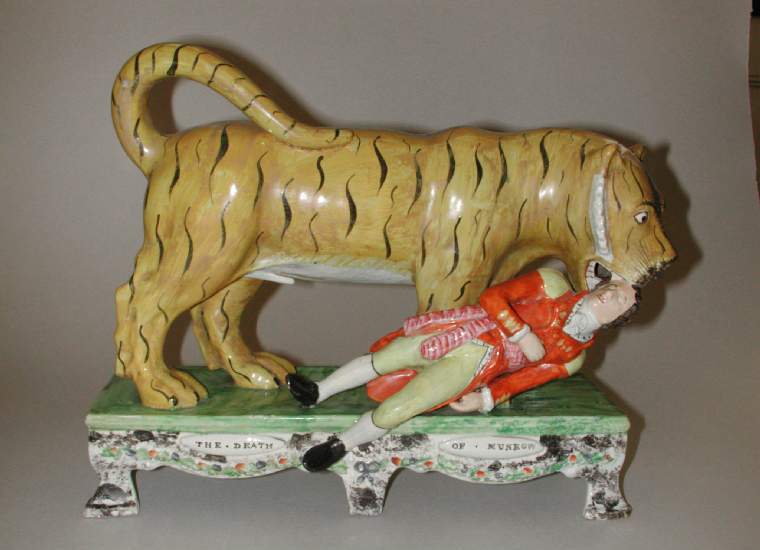Current Location: Gallery 27 (Glaisher)
Titles
The Death of Monrow
Maker(s)
Factory:
Unidentified factory
(Probably)
Entities
Categories
Description
Earthenware figure group, moulded with modelled additions, lead glazed and painted with polychrome enamels.
Large animal figure group of a tiger holding the head of a lifeless soldier in its mouth, standing on a rectangular table base. The tiger is yellow with dark vertical markings; a dark stripe along its back runs down the face, which is framed by prominent white whiskers. The soldier has a red uniform, yellow breeches and epaulettes, white stockings and black boots, and wears a pink sash around his waist; his right arm falls down across his body. The base is a grass green rectangular plinth supported on a grey sponged table base which has six feet, a moulded polychrome swag frieze and on the front two raised ovals with the impressed inscription ‘THE.DEATH’ and ‘OF.MUNROW’. The underside is recessed and glazed.
Notes
History note: Bought from Mr Wordingham, Cambridge dealer, on 3 April 1921, by Dr J.W.L. Glaisher, FRS, Trinity College, Cambridge. £15 paid for this and a companion piece ‘The Roring Lion’. Both pieces said to have come from Cromer Hall.
Legal notes
Dr J. W. L. Glaisher Bequest
Measurements and weight
Height: 27.5 cm
Acquisition and important dates
Method of acquisition: Bequeathed
(1928-12-07)
by
Glaisher, J. W. L., Dr
Dating
19th Century, second quarter
Circa
1825
CE
-
1835
CE
Note
Lieutenant Hugh Monro, a young army officer serving in India, was mauled by a tiger while on a hunting trip in 1792. His death is thought to have inspired the creation of as automaton, 'Tippoo's Tiger', now in the V&A, which was originally made for the Indian ruler Tipu Sultan and was first exhibited in London in 1799. The modeller of this figure group perhaps saw the exhibit, or a print of it, as he has used a similar design. The mould for the ‘Munrow’ figure, however, seems to have simply been taken from an upright soldier figure.
Pearlware figures and groups decorated with enamels were in production by 1780. They were generally made at smaller potteries and are rarely marked. A cheaper alternative to porcelain, they drew on a variety of sources, including sculpture and porcelain figures. Classical, biblical, mythological and literary subjects were popular, as were animals and representations of rural life, seasons and trades. These early figures are moulded, perhaps with moulded or modelled parts added, the bases often formed separately. After around 1810-1820, figures are often more vibrantly coloured and by c.1835 earlier methods had largely given way to three-part press-moulding, enabling cheaper and faster production for a growing market.
This is one of several Staffordshire lions in the Fitzwilliam collection. The size, base, palette and style of moulding are so similar to the collection’s ‘The Roring Lion’ figure (C.968-1928) that they are probably by the same maker and perhaps companion pieces. In 1921, Dr Glaisher wrote: ‘these two pieces were in such wonderful condition that I felt obliged to buy them’. Figure groups of 'The Death of Munrow' were made from around 1810-30. The table-base here indicates it is one of the later versions. Standing on four or six short legs, table-base groups were made from c.1825-35. Although traditionally attributed to Obadaiah Sherratt, of Burslem, they were probably made by a number of Staffordshire figure makers.
People, subjects and objects depicted
Components of the work
Decoration
composed of
enamels
lead-glaze
Base
Depth 10.5 cm
Width 32 cm
Parts
Materials used in production
Earthenware
Techniques used in production
Moulding
: Earthenware, moulded and modelled, lead glazed and painted with enamels.
Inscription or legends present
- Text: No.4098 Staffordshire Group ‘The Death of Munrow’ b. in Cambridge [?] 1921, said to have come from Cromer Hall. Lieut Munro was carried off by the tiger Dec 22nd 1792.’
- Location: Underside of base
- Method of creation: Rectangular paper label handwritten in black ink
- Type: Label
References and bibliographic entries
Identification numbers
Accession number: C.967-1928
Primary reference Number: 76467
Old object number: 4098
Stable URI
Audit data
Created: Saturday 6 August 2011
Updated: Friday 24 January 2025
Last processed: Tuesday 15 July 2025
Associated departments & institutions
Owner or interested party:
The Fitzwilliam Museum
Associated department:
Applied Arts





